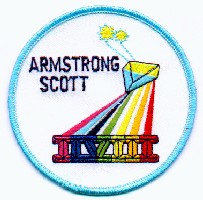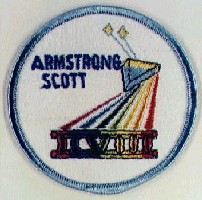
March 16, 1966

Crew & Mission
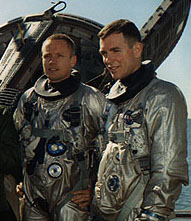 The prime crew and back-up crew for the Gemini-VIII mission were selected on September 29, 1965. The prime crew would be: Neil A. Armstrong and David R. Scott, and the back-up crew: Pete Conrad and Dick Gordon.
The prime crew and back-up crew for the Gemini-VIII mission were selected on September 29, 1965. The prime crew would be: Neil A. Armstrong and David R. Scott, and the back-up crew: Pete Conrad and Dick Gordon.
Gemini-VIII was launched from Cape Kennedy, March 16, 1966, at 11:41:02 am EST. One hour and 41 minutes after the launch of the Gemini-VII Agena target vehicle. Both launches went as scheduled.
Six hours after lift-off the first rendezvous of the Gemini spacecraft and the unmanned target vehicle had been accomplished. This was followed shortly by the first docking of two vehicles in space. This was at six hours, 33 minutes, and 22 seconds MET.
Approximately 27 minutes after docking, the Gemini-Agena combination encountered greater than expected yaw and roll rates. The crew attempted to bring the vehicles under control by giving various commands to the Agena. When it became evident this action would not be effective, Armstrong and Scott suspected some part of the spacecraft control system might be involved. The rates increased to a point where the crew felt the structural integrity of the combination might be in jeopardy, and they then succeeded in reducing the rates to a point where they could safely undock from the Agena and back away as quickly as possible.
After completing this maneuvre it was evident that the spacecraft's attitude control system had caused the problem. Roll and yaw rates of the spacecraft rapidly increased to such an extent that it was making almost one full revolution per second. The roll was brought under control by deactivating the orbital attitude maneuvre system and by activating the reentry control system.
Flight Director John D. Hodge assessed the situation, and ordered the mission terminated during the seventh revolution of Earth. This required a landing in a secondary recovery area in the Pacific. Gemini-VIII touched down in the western pacific, east of Okinawa, after a flight of 10 hours, 41 minutes, and 26 seconds. Touchdown was about 1.1 miles south of the planned landing area at 10:22:28 pm, EST. The crew was picked up by the USS Mason, a destroyer, at 1:28 am, EST, March 17, and the spacecraft was picked up an hour and nine minutes later.
A Personal Story
"The light from the twin Gemini stars is split by a prism in a spectrum of color spelling Gemini VIII. This indicates that the flight objectives cover the complete spectrum of Gemini program objectives (i.e. rendezvous, docking, EVA and experiments)."
The Artwork
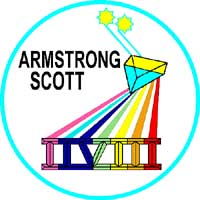
The Gemini-8 astronauts wanted their crew patch to reflect a wide spectrum of objectives including rendezvous, docking, EVA and scientific experiments. Their flight patch featured Castor and Pollux, the twin stars in the constellation of Gemini whose light is shown being split by a prism into a spectrum of colours forming the zodiac symbol for Gemini (II) followd by the Roman numeral for eight (VIII). The names of both crew members appear on the patch.
Unfortunately, the wide spectrum of objectives symbolised by their patch, were not realised as the flight was terminated early due to a spacecraft attitude control system problem.
Spot the Patch !!!
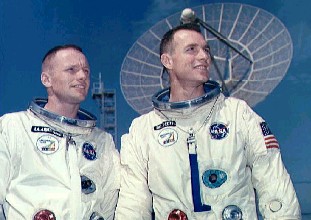
Souvenir
